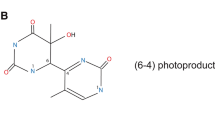Abstract
Cockayne syndrome (CS) is an autosomal recessive disorder with dwarfism, mental retardation, sun sensitivity and a variety of other features. Cultured CS cells are hypersensitive to ultraviolet (UV) light, and following UV irradiation, CS cells are unable to restore RNA synthesis rates to normal levels. This has been attributed to a specific deficiency in CS cells in the ability to repair damage in actively transcribed regions of DNA at the rapid rate seen in normal cells. We have used the failure of recovery of RNA synthesis, following UV irradiation of CS cells, in a complementation test. Cells of different CS donors are fused. Restoration of normal RNA synthesis rates in UV irradiated heterodikaryons indicates that the donors are in different complementation groups, whereas a failure to effect this recovery implies that they are in the same group. In an analysis of cell strains from 22 CS donors from several countries and different racial groups, we have assigned five cell strains to the CS-A group and the remaining 17 to CS-B. No obvious racial, clinical or cellular distinctions could be made between individuals in the two groups. Our analysis will assist the identification of mutations in the recently clonedCSA andCSB genes and the study of structure-function relationships.
Similar content being viewed by others
References
Bootsma D, Hoeijmakers JHJ (1993) Engagement with transcription. Nature 363:114–115
Bootsma D, Hoeijmakers JHJ (1994) The molecular basis of nucleotide excision repair syndromes. Mutat Res 307:15–23
Broughton BC, Thompson AF, Harcourt SA, Vermeulen W, Hoeijmakers JHJ, Botta E, Stefanini M, et al (1995) Molecular and cellular analysis of the DNA repair defect in a patient in xeroderma pigmentosum complementation group D who has the clinical features of xeroderma pigmentosum and Cockayne syndrome. Am J Hum Genet 56:167–174
Cleaver JE, Volpe JPG, Charles WC, Thomas GH (1994) Prenatal diagnosis of xerodenna pigmentosum and Cockayne syndrome. Prenat Diagn 14:921–928
Hanawalt P, Donahue BA, Sweder KS (1994) Collision or collusion? Curr Biol 4:518–521
Henning KA, Li L, Iyer N, Mc Daniel L, Reagan MS, Legerski R, Schultz RA et al (1995) The Cockayne syndrome complementation group A (CSA) gene encodes a WD-repeat protein that interacts with CSB protein and with a subunit of RNA polymerase II TFIIH. Cell 82:555–564
Lehmann AR (1982) Three complementation groups in Cockayne syndrome. Mutat Res 106:347–356
Lehmann AR (1987) Cockayne's syndrome and trichothiodystrophy: defective repair without cancer. Cancer Rev 7:82–103
Lehmann AR, Francis AJ, Giannelli F (1985) Prenatal diagnosis of Cockayne's syndrome. Lancet I:486–488
Lehmann AR, Thompson AF, Harcourt SA, Stefanini M, Norris PG (1993) Cockayne's syndrome: correlation of clinical features with cellular sensitivity of RNA synthesis to UV irradiation. J Med Genet 30:679–683
Lehmann AR, Bootsma D, Clarkson SG, Cleaver JE, Mc Alpine PJ, Tanaka K, Thompson LH, Wood RD (1994) Nomenclature of human DNA repair genes. Mutat Res 315:41–42
Miyauchi H, Horio T, Akaeda T, Asada Y, Chang HR, Ishizaki K, Ikenaga M (1994) Cockayne syndrome in two adult siblings. J Am Acad Dermatol 30:329–335
Nance MA, Berry SA (1992) Cockayne syndrome: review of 140 cases. Am J Med Genet 42:68–84
Selby CP, Sancar A (1993) Molecular mechanism of transcriptionrepair coupling. Science 260:53–58
Selby CP, Witkin EM, Sancar A (1991) Escherichia coli mfd mutant deficient in “mutation frequency decline” lacks strand-specific repair: in vitro complementation with purified coupling factor. Proc Natl Acad Sci USA 88:11574–11578
Stefanini M, Lagomarsini P, Arlett CF, Marinoni S, Borrone C, Crovato F, Trevisan G, et al (1986) Xeroderma pigmentosum (complementation group D) mutation is present in patients affected by trichothiodystrophy with photosensitivity. Hum Genet 74:107–112
Stefanini M, Lagomarsini P, Giorgi R, Nuzzo F (1987) Complementation studies in cells from patients affected by trichothiodystrophy with normal or enhanced UV photosensitivity. Mutat Res 191:117–119
Stefanini M, Giliani S, Nardo T, Marinoni S, Nazzaro V, Rizzo R, Trevisan G (1992) DNA repair investigations in nine Italian patients affected by trichothiodystrophy. Mutat Res 273:119–125
Stefanini M, Lagomarsini P, Giliani S, Nardo T, Botta E, Peserico A, Kleijer WJ, et al (1993) Genetic heterogeneity of excision repair defect associated with trichothiodystrophy. Carcinogenesis 14:1101–1105
Tanaka K, Kawai Y, Kumahara Y, Ikenaga M, Okada Y (1981) Genetic complementation groups in Cockayne syndrome. Somat Cell Genet 7:445–455
Troelstra C, Odijk H, Wit J de, Westerveld A, Thompson LH, Bootsma D, Hoeijmakers JHJ (1990) Molecular cloning and biological characterization of the human DNA excision repair gene ERCC-6. Mol Cell Biol 10:5806–5813
Troelstra C, Van Gool A, Wit J de, Venneulen W, Bootsma D, Hoeijmakers JHJ (1992) ERCC6, a member of a subfamily of putative helicase, is involved in Cockayne's syndrome and preferential repair of active genes. Cell 71:939–953
Van Hoffen A, Natarajan AT, Mayne LV, Van Zeeland AA, Mullenders LHF, Venema J (1993) Deficient repair of the transcribed strand of active genes in Cockayne's syndrome cells. Nucleic Acids Res 21:5890–5895
Venema J, Mullenders LHF, Natarajan AT, Zeeland AA van, Mayne LV (1990) The genetic defect in Cockayne syndrome is associated with a defect in repair of UV-induced DNA damage in trascriptionally active DNA. Proc Natl Acad Sci USA 87:4707–4711
Vermeulen W, Stefanini M, Giliani S, Hoeijmakers JHJ, Bootsma D (1991) Xeroderma pigmentosum complementation group H falls into complementation group D. Mutat Res 255:201–208
Vermeulen W, Jaeken J, Jaspers NGJ, Bootsma D, Hoeijmakers JHJ (1993) Xeroderma pigmentosum complementation group G associated with Cockayne syndrome. Am J Hum Genet 53:185–192
Vermeulen W, Scott RJ, Rodgers S, Muller HJ, Cole J, Arlett CF, Kleijer WJ, et al (1994) Clinical heterogeneity within xeroderma pigmentosum associated with mutations in the DNA repair and transcription gene ERCC3. Am J Hum Genet 54:191–200
Author information
Authors and Affiliations
Corresponding author
Rights and permissions
About this article
Cite this article
Stefanini, M., Fawcett, H., Botta, E. et al. Genetic analysis of twenty-two patients with Cockayne syndrome. Hum Genet 97, 418–423 (1996). https://doi.org/10.1007/BF02267059
Received:
Issue Date:
DOI: https://doi.org/10.1007/BF02267059




